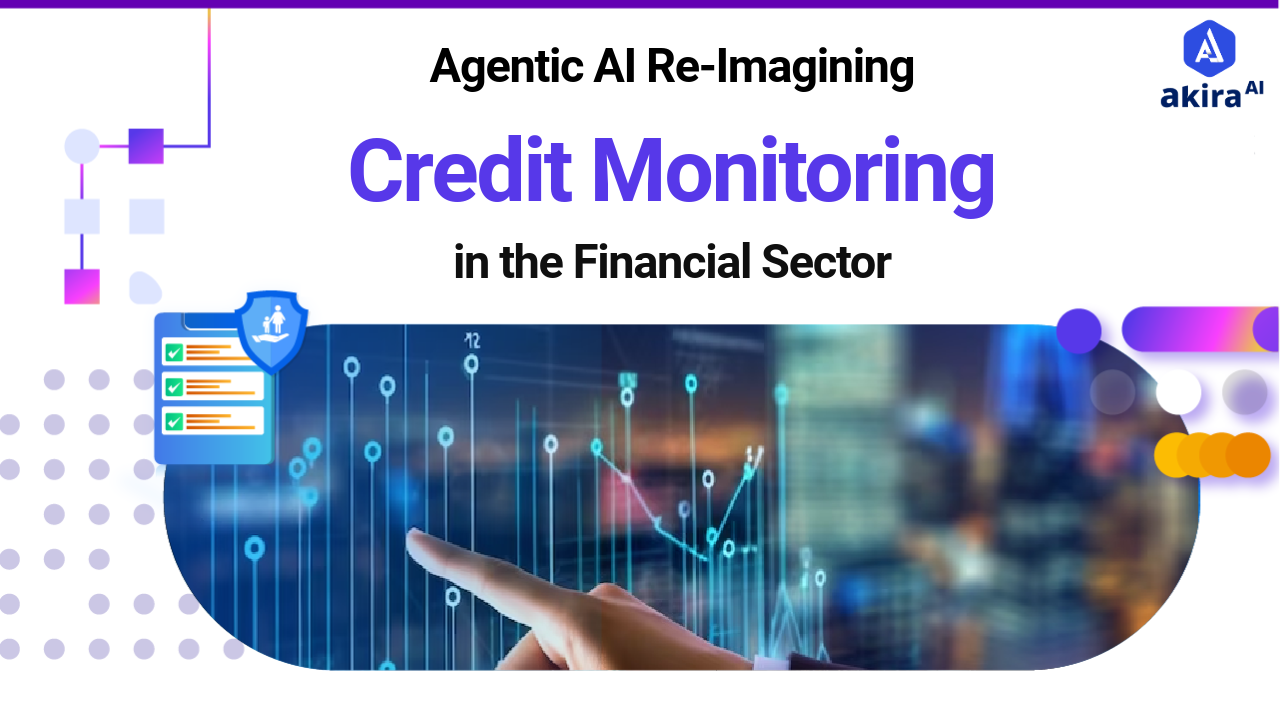Agentic AI-driven credit monitoring enhances security by providing real-time fraud detection and personalized credit health recommendations. AI agents analyze financial data, predict risks, and ensure compliance with regulations, offering proactive protection. This approach improves operational efficiency, reduces human error, and empowers consumers to manage their credit effectively. The future of credit monitoring is shaped by AI’s ability to offer smarter, more personalized financial solutions.
Financial fraud is on the rise, with identity theft and unexpected credit score drops affecting countless individuals each year. As traditional credit monitoring services can often be reactive, leaving consumers unaware of potential threats until it’s too late, many are turning to AI-driven solutions for a more proactive approach. AI teammates are intelligent systems that not only monitor your credit score but also analyze your spending habits, detect unusual activities, and alert you in real-time when something seems amiss. This capability allows consumers to stay on top of their finances and protect themselves from potential fraud before it impacts their credit.
Beyond just monitoring, AI Agents are designed to predict risks and provide personalized recommendations for improving financial health. By continuously learning from your behavior, AI systems become increasingly effective at identifying patterns, detecting fraud attempts, and even preventing them. These tools offer more than just alerts—they provide actionable insights and customized advice to help you manage your credit more effectively. In this blog, we explore how Agentic AI is transforming the way individuals safeguard their financial well-being, offering smarter, more efficient solutions for credit monitoring and financial protection.
What is Credit Monitoring?
Credit monitoring is the process of regularly tracking and reviewing an individual’s credit report to detect any changes or activities that could affect their credit score. It involves monitoring factors such as credit inquiries, new accounts, outstanding debts, and payment history. The purpose of credit monitoring is to help individuals stay informed about their credit status, catch signs of identity theft or fraud early, and take necessary actions to protect or improve their credit scores.
These services typically alert consumers about significant changes in their credit reports, such as new credit accounts opened in their name, missed payments, or credit inquiries. These services can also provide credit score updates and offer recommendations on how to maintain or improve credit health. By actively monitoring their credit, individuals can reduce the risks associated with fraud and identity theft while making informed decisions about their financial future.
A Brief Overview of AI Teammates for Credit Monitoring in Finance
AI teammates for credit monitoring in finance represent the next evolution of financial security and management. These AI-powered systems leverage advanced machine learning algorithms to analyze and track an individual’s credit report and financial data in real-time. Unlike traditional credit monitoring methods that offer periodic updates, AI teammates continuously monitor your credit, automatically detecting changes, discrepancies, or suspicious activities as soon as they occur. By identifying potential issues such as fraudulent transactions, missed payments, or identity theft, AI Agents enable individuals to respond swiftly and take preventive actions to protect their credit health.
It not only provides alerts but also offers valuable insights and suggestions on how to improve your credit score and financial health. They analyze patterns in spending, debt repayment, and credit usage to provide personalized recommendations tailored to the individual’s financial goals. These intelligent systems are designed to be proactive, learning from data to predict future risks and trends, thus enhancing the security and efficiency of credit monitoring. As a result, AI teammates empower users to take charge of their financial future, ensuring they remain in control of their credit scores and financial opportunities.
Traditional vs. Agentic AI Credit Monitoring
| Aspect | Traditional Approaches | Agentic AI Approaches |
| Data Processing | Manual analysis of credit reports, spreadsheets, and historical data. | Automated data processing using machine learning and natural language processing. |
| Speed | Slow, often requiring hours or days for processing. | Real-time analysis, enabling instant decision-making. |
| Accuracy | Prone to human error and oversight. | High precision, reducing mistakes and inconsistencies. |
| Fraud Detection | Relies on rule-based systems or manual checks. | AI detects anomalies and patterns that may indicate fraud. |
| Customer Personalization | Limited personalization, based on standard criteria. | Highly personalized recommendations tailored to individual credit profiles. |
| Scalability | Difficult to scale without additional staff or resources. | Easily scalable, capable of handling millions of data points simultaneously. |
Akira AI: Multi-Agent in Action

To appreciate the extent of the innovation brought by AI agents for credit monitoring over the years, it would be pertinent to explore their use over a given period.
- Credit Monitoring Agent: This agent integrates data from various financial systems, such as credit scores, banking transactions, and claims processing. It continuously tracks changes in the user’s credit behavior, enabling the detection of any significant shifts in their financial status. The agent plays a pivotal role in overall credit health monitoring.
- Data Collection and Validation Agent: This agent gathers data from multiple sources like credit bureaus, financial institutions, and loan providers. It ensures that the collected data is accurate, complete, and up-to-date, which is crucial for proper decision-making and further analysis in the credit monitoring process.
- Anomaly Detection Agent: Using machine learning techniques, this agent identifies unusual or suspicious activity in a customer’s credit history. It alerts users and institutions to potential risks, such as fraud or sudden changes in spending behavior, by flagging these discrepancies in real time for further investigation.
- Ensure Compliance Agent: This agent ensures that all credit monitoring activities adhere to industry standards and regulations. It checks compliance with reporting rules, legal frameworks, and financial regulations, generating the necessary reports for businesses to remain compliant and avoid legal issues.
- Master Orchestrator Agent: The orchestrator agent manages the workflow by coordinating the actions of the other agents. It uses a knowledge graph and large language models (LLMs) to ensure smooth communication and orchestration of the entire credit monitoring process, consolidating insights into actionable recommendations.
Use Cases and Application of Credit Monitoring in Finance
- Credit Risk Assessment: AI-driven systems evaluate a customer’s lending risk by analyzing parameters such as credit history, income, and spending habits. This helps financial institutions make more informed lending decisions, minimizing the risk of defaults.
- Fraud Prevention: Advanced algorithms can detect anomalies in credit behavior, flagging activities like identity theft, forged loan applications, or credit card misuse. These systems identify suspicious patterns and proactively mitigate risks.
- Personalized Credit Improvement: Smart systems provide tailored recommendations to help individuals improve their credit scores. These suggestions may include strategies like paying down specific debts or changing credit card usage habits.
- Automated Credit Report Monitoring: Credit monitoring tools constantly track changes in users’ credit reports, sending alerts if there are significant alterations, such as new accounts being opened, defaults, or potential fraudulent activity.
- Debt Collection Optimization: Agent-driven workflows are deployed to streamline debt collection processes. These systems identify the most effective strategies for reaching out to customers and improving recovery rates while reducing operational costs.
Technologies Transforming for Credit Monitoring
- Machine Learning: By incorporating machine learning algorithms, systems continuously improve over time, utilizing historical data to boost efficiency and enhance predictive accuracy.
- Natural Language Processing (NLP): NLP ensures seamless communication between users and systems, enabling them to interpret and process any language without complications.
- Predictive Analytics: Through advanced predictive models, AI provides valuable insights into potential future credit behavior and market trends, aiding financial institutions in better risk management and decision-making.
- Big Data Analytics: Big data plays a crucial role in refining credit policies and practices, allowing for more efficient process management and improved decision-making across financial operations.
Operational Benefits of Credit Monitoring in Banking
- Improved Accuracy: Automation significantly reduces human error, enhancing the overall accuracy of credit monitoring processes by up to 40%. This leads to more reliable data analysis and fewer mistakes in credit assessments and reporting.
- Proactive Risk Management: With the ability to continuously monitor transactions and behaviors, the system identifies potential risks early, reducing financial losses by as much as 60%. This proactive approach helps prevent issues before they escalate.
- Faster Decision-Making: Real-time data analysis accelerates decision-making by up to 50%, allowing financial institutions to respond quickly to changing circumstances, such as credit score fluctuations or suspicious activity.
- Regulatory Compliance: The system ensures 100% adherence to regulatory standards, eliminating the risk of penalties and legal challenges. This maintains compliance and helps build trust with customers and stakeholders.
- Operational Efficiency: By automating routine monitoring tasks, the system reduces the workload on analysts by up to 70%. This frees up resources to focus on higher-value strategic initiatives, improving productivity and efficiency across the organization.
- Enhanced Data Security: The system employs robust security protocols to safeguard sensitive data, ensuring that privacy regulations are met. This builds trust among customers and stakeholders, while also aligning with industry standards for data protection.
The Future Trends of AI Teammates for Credit Monitoring
With these anticipated developments, the role of AI teammates in credit monitoring can better be appreciated:
- Hyper-Personalization through Predictive Analytics: AI teammates will increasingly offer tailored credit advice and services by analyzing individual consumer behavior, financial history, and predictive models. This personalized approach will help clients improve their credit scores, optimize financial habits, and access better lending opportunities.
- Integration with Alternative Data Sources: The use of alternative data sources, such as social media activity, payment behavior, and utility bills, will become more prevalent. AI will integrate these data points to offer more accurate credit risk assessments and improve access to financial services, particularly for underserved populations with limited traditional credit histories.
- Automated Compliance and Regulatory Monitoring: As financial regulations become more complex, AI systems will play a crucial role in ensuring compliance with credit monitoring laws and industry standards. They will automatically update and adapt to regulatory changes, minimizing human error and reducing the risk of penalties for financial institutions.
- Greater Use of Blockchain for Data Security: AI-powered credit monitoring systems will increasingly incorporate blockchain technology to ensure the secure and transparent sharing of financial data. This integration will not only protect sensitive information but also build trust with consumers, who will have more control over their data.
- Seamless Multi-Platform Integration: AI teammates will enable seamless integration across multiple platforms, allowing financial institutions to deliver consistent credit monitoring services across digital channels, mobile apps, and traditional in-person interactions. This multi-channel approach will offer greater accessibility and convenience for customers.
Conclusion: AI Agents for Credit Monitoring
In conclusion, Agentic AI-driven credit monitoring is revolutionizing the way individuals and financial institutions manage credit security. By leveraging AI agents, these systems provide real-time insights, predictive analytics, and personalized recommendations that enable proactive protection against financial risks. As technology continues to evolve, it will play a key role in empowering individuals to take control of their credit while helping financial institutions streamline operations and reduce risk. The future of credit monitoring is clearly defined by Agentic AI, offering smarter, more secure, and personalized financial experiences.



